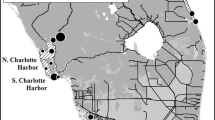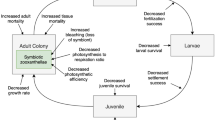Abstract
This study evaluated changes in oyster tissue contaminant levels following North Atlantic tropical cyclones to determine if changes in contaminant concentrations were predictable. The basis for this study was analysis of coastal chemical contaminant data from the National Oceanic and Atmospheric Administration’s (NOAA) National Status and Trends Mussel Watch Program and NOAA’s National Weather Service storm track data. The tendency for contaminant (metals and organic compounds) body burdens to increase or decrease in oyster tissue after a storm was assessed using contingency and correspondence analyses. Post-storm contaminant levels in oysters revealed a consistent pattern of distribution, which could be described as follows: (1) most of the organic contaminants stay within their long-term concentration ranges, (2) very few organic contaminants decreased, and (3) metals overwhelmingly tend to increase.
Similar content being viewed by others
References
Apeti, A. D., Robinson, L., & Johnson, E. (2005). Relationship between heavy metal concentrations in the American oyster (Crassostrea virginica) and metal levels in the water column and sediment in Apalachicola Bay, Florida. American Journal of Environmental Sciences, 1(3), 179–186.
Bales, J. D., Oblinger, C. J., & Sallenger, A. H., Jr. (2000). Two months of flooding in Eastern North Carolina, September-October 1999. Hydrologic, water quality, and geologic effects of hurricanes Dennis, Floyd, and Irene. Water Resources Investigations Report 00-4093, U.S. Geological Survey.
Brandenberger, J. M., May, C. W., Cullinan, V. I., & Johnston, R. K. (2007). Surface and stormwater quality assessment for Sinclair and Dyes inlet, Washington, Pacific Northwest National Laboratory Report. Available online at http://www.dtic.mil/cgi-bin/GetTRDoc?Location=U2&doc=GetTRDoc.pdf&AD=ADA519150.
Bushek, D., Heidenreich, M., & Porter, D. (2007). The effects of several common anthropogenic contaminants on proliferation of the parasitic oyster pathogen Perkinsus marinus. Marine Environmental Research, 64, 535–540.
Capuzzo, M. J. (1996). The bioaccumulation and biological effects of lipophilic organic contaminants. In V. S. Kennedy, R. I. E. Newell, & A. F. Eble (Eds.), Eastern oyster Crassostrea virginica (pp. 539–557). College Park: Maryland Sea Grant College.
DiGiacomo, P. M., Washburn, L., Holt, B., & Jones, B. H. (2004). Coastal pollution in southern California observed by SAR imagery: Stormwater plume, wastewater plumes and natural hydrocarbon seeps. Marine Pollution Bulletin, 49, 1013–1024.
Encomio, V., & Chu, F.-L. E. (2000). The effect of PCBs on glycogen reserves in the eastern oyster Crassostrea virginica. Marine Environmental Research, 50, 45–49.
Farris, G. S., Smith, G. J., Crane, M. P., Demas, C. R., Robbins, L. L., & Lavoie, D. L. (Eds.) (2007). Science and the storms-the USGS response to the hurricanes of 2005. U.S. Geological Survey Circular, 1306(283), 201–206.
FDACS, Florida Department of Agriculture and Consumer Services (2005). Shellfish harvesting. Division of aquaculture. Available online at www.floridaaquaculture.com. Accessed on 28 February 2008.
Gagnaire, B., Thomas-Guyon, H., & Renault, T. (2004). In-vitro effects of cadmium and mercury on Pacific oyster Crassostrea gigas (Thunberg), haemocytes. Fish and Shellfish Immunology, 16, 501–512.
Guiney, J. L. (1999). Preliminary report hurricane George 15 September–01 October 1998. National Hurricane Center, http://www.nhc.noaa.gov/1998georges.
Guiney, J. L., & Lawrence, M. B. (1999). Preliminary report hurricane Mitch 22 October–05 November 1998. National Hurricane Center, www.nhc.noaa.gov/archive/storm.
Johnson, W. E., Kimbrough, K. L., Lauenstein, G. G., & Christensen, J. (2009). Chemical contamination assessment of Gulf of Mexico oysters in response to hurricanes Katrina and Rita. Environmental Monitoring and Assessment, 150, 211–225.
Kim, Y., Powell, E. N., Wade, T. L., Presley, B. J., & Brooks, J. M. (1999). Influence of climate change on interannual variation in contaminant body burden in Gulf of Mexico oysters. Marine Environmental Research, 48, 459–488.
Kimbrough, K. L., & Lauenstein, G. G. (2007). Major and trace element analytical methods of the National Status and Trends Program: 2000–2006. NOAA Technical Memorandum NOS NCCOS 29, Silver Spring, MD.
Kimbrough, K. L., Lauenstein, G. G., & Johnson, W. E. (2007). Organic contaminant analytical methods of the National Status and Trends Program: Update 2000–2006. NOAA Technical Memoranda NOS NCCOS 30, Silver Spring, MD.
Lauenstein, G. G., & Cantillo, A. Y. (1998). Sampling and analytical methods of the National Status and Trends Program Mussel Watch Project: 1993–1996 Update. NOAA Technical Memorandum NOS NCCOS 130.
Lawrence, M. B. (1998). Preliminary report, tropical storm Frances 08–13 September 1998. National Hurricane Center, www.nhc.noaa.gov/archive/storm.
Lawrence, M. B. (2003). Tropical cyclone report, hurricane Lili 21 September–04 October 2002. National Hurricane Center, www.nhc.noaa.gov/archive/storm.
Lin, S., & Hsieh, I.-J. (1999). Occurrence of green oyster and heavy metals contaminant levels in the Sien-San area, Taiwan. Marine Pollution Bulletin, 38, 960–965.
Mayfield, M. (1989). Preliminary report hurricane Jerry 12–16 October 1989. National Hurricane center, www.nhc.noaa.gov/archive/storm.
National Weather Service (2010). The Saffir-Simpson hurricane wind scale. National Hurricane Center, http://www.nhc.noaa.gov/aboutsshws.shtml.
Neff, J. M. (1979). Polycyclic aromatic hydrocarbons in aquatic environment, sources, fates and biological effects. London: Applied Science.
NHC (1988). Preliminary report hurricane Florence 7–11 September 1988. National Hurricane Center, www.nhc.noaa.gov/archive/storm.
NHC (1999). The 1998 Atlantic hurricanes season. National Hurricane Center, www.nhc.noaa.gov/1998.html.
NWS (2007). Tropical cyclone structure. Jet stream-an online school for weather. National Oceanic and Atmospheric Administration, www.srh.noaa.gov.
Ogston, A. S., Cacchione, D. A., Sternberg, R. W., & Kineke, G. C. (2000). Observations of storm and river flood-driven sediment transport on the northern California continental shelf. Continental Shelf Research, 20(16), 2141–2162.
Pasch, R. J. (1995). Preliminary report hurricane Gordon 8–21 November 1994. National Hurricane Center, www.nhc.noaa.gov/archive/storm.
Pasch, R. J. (1996). Preliminary report: Tropical storm Josephine 4–8 October 1996. National Hurricane Center, www.nhc.noaa.gov/1996josephin.html.
Presley, S. M., Rainwater, T. R., Austin, G. P., Platt, S. G., Zack, J. C., Cobb, G. P., et al. (2005). Assessment of pathogens and toxicants in New Orleans, LA following hurricane Katrina. Environmental Science and Technology, 40(2), 468–474. http://pubs.acs.org/cgi-bin/sample.cgi/esthag/2006/40/i02/html/es052219p.html.
Reinfelder, J. R., Fisher, N. S., Luoma, S. N., Nichols, J. W., & Wang, W.-X. (1998). Trace element trophic transfer in aquatic organisms: A critique of the kinetic model approach. The Science of the Total Environment, 219, 117–135.
Roesijadi, G. (1996). Environmental factors: Response to metals. In V. S. Kennedy, R. I. E. Newell, & A. F. Eble (Eds.), Easter oyster Crassostrea virginica (pp. 515–537). College Park: Maryland Sea Grant College.
Salazar, M. H., & Salazar, S. M. (1995). In situ bioassay using transplanted mussels: I. Estimating chemical exposure and bioeffects with bioaccumulation and growth. In J. S. Hughes, G. R. Biddinger, & E. Mones (Eds.), Environmental toxicology and risk assessment (Third Vol., ASTM STP 1218, pp. 216–241). Philadelphia: American Society for testing and Materials.
Sauve, S., Brousseau, P., Pèlerin, J., Morin, Y., Senecal, L., Goudreau, M., & Fournier, M. (2002). Phagocytic activity of marine and freshwater bivalves: In vitro exposures of hemocytes to metals (Ag, Cd, Hg, and Zn). Aquatic Toxicology, 58, 189–200.
Schroeder, W. W., & Wiseman, W. J. (1999). In T. S. Bianchi, J. R. Pennock, & R. R. Twilley (Eds.), Geology and hydrodynamics of Gulf of Mexico estuaries (pp. 3–28). Toronto, Canada: John Wiley & Son, Inc.
Sericano, J. L., Wade, T. L., & Brooks, J. M. (1996). Accumulation and depuration of organic contaminants by the American oyster (Crassostrea virginica). The Science of the Total Environment, 179, 149–160.
Shiller, A. M., & Boyle, E. A. (1991). Trace element in the Mississippi River Delta outflow region: Behavior at high discharge. Geochimica Cosmochimica Acta, 55, 3241–3251.
Solis, R. S., & Powell, G. L. (1999). In T. S. Bianchi, J. R. Pennock, & R. R. Twilley (Eds.), Hydrographic, mixing characteristics, and residence times of Gulf of Mexico estuaries (pp. 29–61). Toronto, Canada: John Wiley & Son, Inc.
Stewart, T. R. (2002). Tropical cyclone report, tropical storm Fay 5–11 September, 2002. National Hurricane Center, www.nhc.noaa.gov/archive/storm.
Stewart, T. R. (2004). Tropical cyclone report, hurricane Ivan 5–24 September, 2004. National Hurricane Center, www.nhc.noaa.gov/archive/storm.
Weis, P., Weis, J. S., Couch, J., Daniels, C., & Chen, T. (1994). Pathological and genotoxicological observation in oysters (Crassostrea virginica) living on chromated copper arsenate (CCA)-treated wood. Marine Environmental Research, 39, 275–278.
Wen, L.-W., Shiller, A., Santchi, P. H., & Gill, G. (1999). In T. S. Bianchi, J. R. Pennock, & R. R. Twilley (Eds.), Trace element behavior in Gulf of Mexico estuaries (pp. 303–346). Toronto, Canada: John Wiley & Son, Inc.
Author information
Authors and Affiliations
Corresponding author
Rights and permissions
About this article
Cite this article
Apeti, D.A., Lauenstein, G.G., Christensen, J.D. et al. Assessment of coastal storm impacts on contaminant body burdens of oysters collected from the gulf of Mexico. Environ Monit Assess 181, 399–418 (2011). https://doi.org/10.1007/s10661-010-1837-1
Received:
Accepted:
Published:
Issue Date:
DOI: https://doi.org/10.1007/s10661-010-1837-1




